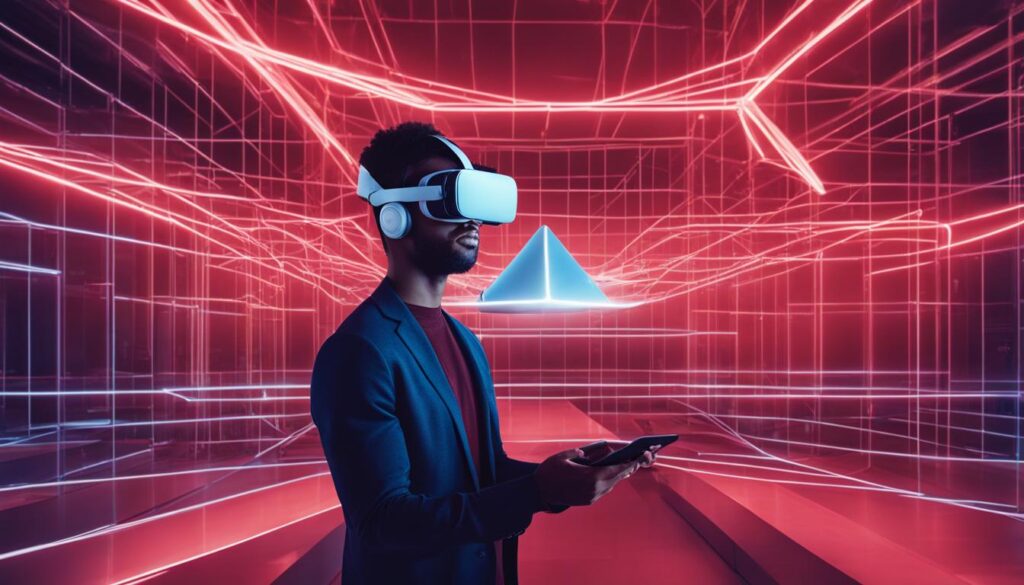Welcome to the fascinating world of augmented reality (AR) and its immense potential for social networking. As technology continues to advance at an unprecedented pace, we find ourselves on the cusp of a new era of immersive experiences and authentic connections. From the comfort of your smartphone, you can now unlock a world where digital overlays and effects seamlessly blend with our physical reality, transforming how we navigate, shop, and connect with others.
But amidst the excitement and possibilities of AR, one question arises: Is there a Facebook of augmented reality? Can we expect a social media platform specifically designed for AR enthusiasts, where a vibrant community can come together to share experiences and create meaningful connections?
In this article, we delve into the world of AR social networking platforms, exploring the idea of a “Facebook-like” platform for augmented reality and the efforts being made by tech giants like Facebook to shape the future of AR. Join us as we examine the rise of AR and VR technologies, Facebook’s vision for the metaverse, its AR vs. VR strategy, and its dominance in the AR space.
Contents
- 1 The Rise of AR and VR
- 2 Facebook’s Vision for the Metaverse
- 3 Facebook’s AR Dominance
- 4 Conclusion
- 5 FAQ
- 5.1 Is there a social media platform for augmented reality (AR)?
- 5.2 What is the difference between augmented reality (AR) and virtual reality (VR)?
- 5.3 How can AR and VR break down barriers?
- 5.4 What is Facebook’s vision for the metaverse?
- 5.5 What is Facebook’s strategy for AR and VR?
- 5.6 How does Facebook dominate in the AR space?
- 5.7 What are some practical applications of AR beyond social media?
- 5.8 How does Facebook aim to shape the future of AR?
- 6 Source Links
Key Takeaways:
- 1. Augmented reality (AR) holds the potential to revolutionize social networking by merging the digital and physical worlds.
- 2. Facebook is investing in AR and VR technologies to build a social network for AR, similar to its dominance in the traditional social media space.
- 3. The metaverse is a digital world envisioned by Facebook where people can gather and interact, surpassing physical limitations.
- 4. Facebook’s commitment to AR and VR technologies is evident through its significant investment in underlying technologies and AI integration.
- 5. Facebook’s AR dominance is exemplified by its social AR ecosystem, spearheaded by Instagram Stories and its democratization of AR creation through AR Studio.
The Rise of AR and VR
AR and VR technologies are on the verge of revolutionizing the way we connect with others and experience the world. Augmented reality (AR) overlays digital information on top of the physical world through smartphones, while virtual reality (VR) provides fully immersive experiences through headsets. These technologies have the potential to break down physical, mental, and societal barriers, enabling meaningful connections regardless of distance or limitations.
AR and VR technology immerses users in virtual environments or enhances their real-world experiences with digital elements. These immersive experiences create a sense of presence, transporting users to different places and altering their perception of reality. By removing physical boundaries, AR and VR allow individuals to explore new worlds, learn new skills, and connect with others in ways that were previously unimaginable.
AR and VR also provide connection possibilities that transcend traditional means of communication. Through AR, users can share real-time information, collaborate remotely, and engage in interactive experiences. VR enables people to join virtual communities, attend events, and interact with others in a simulated environment, overcoming the limitations of physical distance.
AR and VR have the potential to break down mental and societal barriers by creating shared experiences that bridge gaps in understanding and perception.
By blurring the lines between physical and virtual worlds, AR and VR technologies challenge our preconceived notions and expand our horizons. They enable us to step outside our comfort zones and experience things that were previously beyond our reach.
Facebook, a leading tech company, recognizes the transformative power of AR and VR and has invested heavily in these technologies. The company aims to leverage AR and VR to enhance social interactions and shape the future of communication. Facebook’s commitment to AR and VR extends beyond its existing social media platform, as it envisions creating a metaverse where people can come together and interact in virtual spaces.
The possibilities offered by AR and VR are limited only by our imagination. As these technologies continue to advance, we can expect to see new and innovative applications that push beyond the boundaries of what we thought was possible. AR and VR have the potential to revolutionize various industries, from gaming and entertainment to education and healthcare, offering unique and transformative experiences for individuals and society as a whole.
| AR Technologies | VR Technologies |
|---|---|
| Overlay digital information on the physical world | Create fully immersive virtual environments |
| Accessed through smartphones | Requires specialized headsets |
| Breaks down physical boundaries | Transports users to virtual worlds |
| Enables real-time collaboration | Facilitates interactive experiences |
| Offers practical applications in areas like navigation and e-commerce | Enhances gaming and entertainment experiences |
Facebook’s Vision for the Metaverse
In their pursuit of pushing the boundaries of augmented reality (AR) and virtual reality (VR), Facebook has set its sights on creating a metaverse. Led by Andrew Bosworth, Facebook’s Vice President of Augmented Reality and Virtual Reality, the company envisions a digital world where people can interact and share experiences simultaneously.
Referred to as the metaverse, this virtual realm serves as a connective tissue between different digital worlds. Operating under Facebook’s VR group, known as Reality Labs, the metaverse project aims to eliminate the physical limitations that exist in traditional reality, allowing users to seamlessly transition between virtual spaces.
Facebook’s commitment to building a community and connecting people is the driving force behind the metaverse project. By creating a metaverse that transcends physical limitations, Facebook aims to revolutionize social networking and take it to new heights.
Quotes:
“Our vision for the metaverse is to create a digital world where people can interact and share experiences simultaneously, transcending the limitations of physical reality.” – Andrew Bosworth, Vice President of Augmented Reality and Virtual Reality, Facebook
| Benefits of Facebook’s Metaverse | Impact on Social Networking | Enabling Seamless Transitions |
|---|---|---|
| 1. Connects people in digital worlds | 1. Revolutionizes social networking | 1. Eliminates physical limitations |
| 2. Allows simultaneous sharing of experiences | 2. Enhances social interactions | 2. Enables seamless transitions between virtual spaces |
| 3. Breaks down barriers of distance | 3. Facilitates global connections | 3. Transcends the limitations of physics |
To visualize Facebook’s metaverse concept, imagine a digital realm where people can come together, interact, and share experiences in real-time. This metaverse serves as a connective tissue between various virtual worlds, fostering a sense of community and enabling seamless transitions between different environments.
The possibilities within Facebook’s metaverse are vast. From exploring new immersive experiences to collaborating with others on virtual projects, users have the freedom to venture beyond their physical limitations and engage with digital worlds.

In summary, Facebook’s AR and VR strategy revolves around prioritizing the development of these technologies, investing in computer vision software and unique hardware components, and incorporating artificial intelligence algorithms into its camera. This strategic focus positions Facebook as a key player in the AR and VR industry, competing with other tech giants like Apple and Google.
Facebook’s AR Dominance
Facebook has established itself as the leading player in the augmented reality (AR) space, boasting the largest social AR ecosystem. A significant part of this ecosystem is driven by Instagram Stories, a platform that has catapulted AR effects into the mainstream.
Instagram’s AR effects, which include face filters and masks, have become an integral part of users’ social media engagement. Every day, millions of people experiment with these effects, enhancing their photos and videos with immersive digital overlays.
To further empower creators and users, Facebook has open-sourced its robust AR platform, AR Studio. This means that anyone with a Facebook account can now create and share their own AR effects for the social network. This democratization of AR creation has unlocked a wave of creativity and customization, fueling even more engagement within Facebook’s image-heavy communication features.
Instagram AR Effects:
| Key Features | Benefits |
|---|---|
| Face filters | Transforms selfies with fun and interactive animations |
| Masks | Adds digital masks to photos and videos for playful expressions |
| Virtual backgrounds | Allows users to transport themselves to different environments |
| Animated effects | Brings photos and videos to life with dynamic animations |
This dynamic AR ecosystem on Facebook’s platforms has revolutionized the way people engage with social media content. Users can now personalize their content and express their creativity in unique ways, fostering deeper connections and increasing social media usage.
Facebook’s dedication to AR and its commitment to providing customizable effects through AR Studio have solidified its position as the dominant force in the social AR landscape, setting the stage for the future of immersive social interactions.

| Industry | Practical Applications of AR |
|---|---|
| Navigation | AR enables real-time, context-specific information overlay for efficient navigation and exploration. |
| E-commerce | Virtual dressing rooms powered by AR allow users to try on clothes virtually before purchase. |
| Pharmaceutical | AR provides detailed medication information, including instructions, side effects, and drug interactions. |
| Customer Support | AR-based tutorials offer interactive and immersive troubleshooting and learning experiences. |
Conclusion
In conclusion, Facebook’s focus on augmented reality (AR) and virtual reality (VR) technologies reflects its belief in their potential to shape the future of social interactions and practical applications. By investing in AR, the company aims to create a social network for AR that rivals the popularity of its flagship platform, Facebook. With its dominant position in social AR, Facebook is well-positioned to capitalize on the growing popularity and potential of this technology.
As AR continues to evolve, Facebook is committed to driving innovation and transforming the way we connect and engage with the world around us. The company’s AR strategy aligns with its vision of becoming a leader in the AR and VR space, competing with other tech giants like Apple and Google. By investing significant resources in underlying technologies and hardware components, Facebook aims to stay at the forefront of the AR revolution.
The future of AR holds immense possibilities, with practical applications ranging from enhancing navigation systems to enabling virtual dressing rooms for e-commerce. AR has the power to overlay contextual information onto the physical world, making it a valuable tool in various industries. Facebook’s dedication to AR signals its recognition of the broad range of applications and its determination to be at the forefront of AR innovation.
FAQ
While there isn’t a direct “Facebook of augmented reality,” there are AR social media platforms and community platforms that allow users to connect and share AR experiences. These platforms offer features similar to traditional social media, but with a focus on AR technology and content.
What is the difference between augmented reality (AR) and virtual reality (VR)?
AR overlays digital information on top of the physical world, usually through smartphones, while VR provides fully immersive experiences through headsets. AR augments the real world, enhancing it with digital elements, while VR creates a completely virtual environment.
How can AR and VR break down barriers?
AR and VR have the potential to break down physical barriers by enabling virtual experiences and connections regardless of distance. They can also overcome mental and societal barriers by creating inclusive environments and facilitating meaningful interactions between people.
What is Facebook’s vision for the metaverse?
Facebook envisions the metaverse as a digital world where multiple people can interact and share experiences seamlessly. The goal is to eliminate the limitations of physics and create a connective tissue between different virtual worlds, allowing users to move between spaces effortlessly.
What is Facebook’s strategy for AR and VR?
Facebook considers AR and VR as top priorities and has a dedicated team focused on developing these technologies. The company invests heavily in underlying technologies such as computer vision software and AI cameras. Facebook aims to be a leader in the AR and VR space and compete with other tech giants.
How does Facebook dominate in the AR space?
Facebook’s dominance in the AR space is evident through its largest social AR ecosystem, primarily driven by Instagram Stories. Instagram’s AR effects, like face filters and masks, have gained immense popularity, and millions of users experiment with them daily. Facebook’s AR platform, AR Studio, allows anyone to create AR effects for the social network.
AR has practical applications in various industries. It can enhance navigation systems, enable virtual dressing rooms for e-commerce, display real-time information about pharmaceuticals, and provide interactive customer support tutorials, among other uses. AR’s ability to overlay contextual information onto the physical world makes it a valuable tool in many fields.
How does Facebook aim to shape the future of AR?
Facebook is committed to being at the forefront of AR innovation and driving the future of social interactions and practical applications. The company’s significant investment in AR technologies and its dominance in the social AR ecosystem position it to capitalize on the popularity and potential of AR as it continues to evolve.




